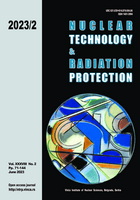
INVESTIGATION OF RADIOLOGICAL PROPERTIES OF IMAGING AGENTS USED IN NUCLEAR MEDICINE WITH DIFFERENT METHODS AND GATE/GEANT4 SIMULATION PROGRAM

Vol.
XXXVIII, No. 2, Pp. 71-144
June 2023
UDC 621.039+614.876:504.06
ISSN 1451-3994
Pages: 116-124
Authors: Turan Sahmaran and Taylan TugrulAbstract
This study aims to determine the radiological properties of various radiopharmaceuticals used in nuclear medicine. In the study, mass attenuation coefficient values in different energy ranges were obtained for six different radiopharmaceuticals dimercaptosuccinic acid, diethylenetriamine pentaacetate, mercaptoacetyltriglycine, hexamethylpropyleneamine oxime, methoxyisobutylisonitrile, methylene diphosphate by using GATE simulation program, XCOM and WinXCom programs. Using these values, effective atomic number and electron density values were calculated with the help of the direct method, interpolation method, Auto-Zeff software, Phy-X/ZeXTra, XMuDat program, and Mayneourd's formula. In addition, the effective atomic number and electron density values obtained were compared for each radiopharmaceutical, both among themselves and between the methods. When radiopharmaceuticals were compared among themselves in low and high-energy regions, the highest effective atomic number values were obtained in dimercaptosuccinic acid, methylene diphosphate, and mercaptoacetyltriglycine. The mass attenuation coefficient values calculated using the GATE code indicate that it is a suitable method for determining the mass attenuation coefficient for imaging agents with no experimental values. This study indicates that the simulation geometry method is suitable to be used as an alternative method for the experiments. In addition, the values obtained for these molecules used as radiopharmaceuticals were examined for the first time.
Key words: radiopharmaceuticals, nuclear medicine, effective atomic number, Monte Carlo
FULL PAPER IN PDF FORMAT (703 KB)